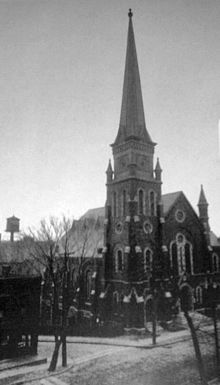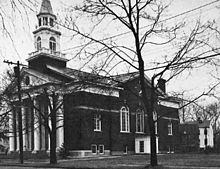First Congregational Church of Albany
In the early 20th century, the church followed its congregants in moving out towards the more suburban areas of Albany being developed along the city's trolley lines.
[1] The church is located at the northwest corner of the intersection of Quail Street and Maple Avenue in the Woodlawn neighborhood 1.5 miles (2.4 km) west of central Albany.
Its lot, just under an acre (41,400 square feet (3,850 m2)) in size, takes up all but the northwest quadrant of the irregularly shaped block between Maple, Quail and Grove and Woodlawn avenues.
[7] Other than the church building, the surrounding neighborhood is residential, consisting mainly of two-story single-family detached homes, with a few three-story and multiple-unit properties, on small lots.
[3]: 5, 11–12 Six full-width stone steps, with four decorative iron handrails, lead up to the entrance portico on the east (front) elevation, which itself is almost as wide as the building.
From the western bay a small brick vestibule with gently pitched gable roof sheltering two glass and wooden doors projects.
[3] On the walls fluted composite pilasters with cushioned egg-and-dart capitals rise to a modillioned entablature with triglyphs at the ceiling line.
In Albany, it took until 1849 before 13 Congregationalists, among them congressman and banker Rufus H. King,[13] were able to take the first step in that direction, when they bought a former Presbyterian church at the corner of Beaver and South Pearl streets near the end of the year.
In October 1852 463 ministers, representing 17 states and parts of Canada, including Lyman Beecher and his son Henry, met at the church to discuss the future of Congregationalism.
However, doctrinal differences between the two, particularly in light of a widening schism among the Presbyterians themselves, had resulted in charges of heresy and revocations of support for some newer synods in Western New York and Ohio.
[3] The convention was also one of the first events in Albany to draw attention to the city outside the state, and even outside the country, due to some of the prominent churchmen of the era in attendance.
So much did the convention impact the city that Albany's Common Council passed an ordinance requiring that the streets around the church, then paved with cobblestone, be covered with tanbark to suppress the noise created by all the wheeled carts rumbling over them.
By 1900, when First Congregational celebrated its 50th anniversary with speeches by prominent residents and a special service honoring the memory of Palmer, who had died in 1886,[16] some of the longtime residents of Albany's downtown area, including some of the church's members, had moved out to newly developed suburban residential areas along the trolley lines that radiated outward.
Charles Hager, pastor at that time, observed that there increasingly seemed to be a surplus of Protestant churches in the area relative to their churchgoers.
The property changed hands for only $35,000, almost $100,000 less than it had cost to building the church a half-century earlier, reflecting the decline in downtown land values in the early 20th century.
The land was inexpensive, a bus line had recently been started down nearby New Scotland Avenue, and several prominent members of the congregation had already moved to the rapidly growing Woodlawn neighborhood themselves.
Electric lighting meant that stained glass windows could be installed on the sides without sacrificing the congregation's ability to read along with the minister.
More specifically, the steel framing used for the structural system probably forced the church to forego the vaulted ceiling in favor of a flat one.
[3] Shortly after concluding its contract with Fuller's firm, in April 1917, the U.S. entered World War I, leading to a shortage of building materials and an increase in costs.
This growth, combined with the church's resulting strong finances, led the trustees of the time to finally undertake finishing Fuller's original design with a Sunday school wing.
[3] The church commissioned Charles Argow Schade, an architect as prominent in Albany as Fuller had been a half-century before, to design a wing more in keeping with the times.
Fuller's design had continued the neoclassicism of the main block, with a broad hipped roof and columns and pilasters like those on the east facade.
Schade, who had designed several other Albany churches of that area, instead delivered a modernist take, keeping the general form and red brick facing but replacing the hipped roof with a gently pitched gable and the classical decoration with more functional modernist touches such as the window bands and full-height glass facade at the wing's main entrance.
Tony Green resigned after John Dennehey, the church's chief deacon, was arrested on charges that he had shown pornography and exposed himself to two boys studying with him in preparation for their confirmation.
After Dennehey's parents, who were described as the most powerful members of the congregation following its recent decline, prevented Green from dismissing him, the pastor felt he had no option but to leave his post in protest.
[18] Dennehey pleaded guilty to a two-count misdemeanor indictment of endangering the welfare of a child; he was sentenced to two months in jail and three years' probation.
In order to build this church, it and its members practice "worship, fellowship, education, service, and outreach in an inclusive and diverse community.
First Congregational holds an annual meeting on the third Sunday of every May at which members are elected to the boards of deacons and trustees, as well as other bodies within the church.
[21] The church holds services every Sunday morning, followed by a coffee fellowship, except for July and August, when it has traditionally taken a "summer vacation."
[23] A partnership with First Israel African Methodist Episcopal Church that began during First Congregational's early 2010s search for a new pastor as a temporary measure has continued after the position was filled.



